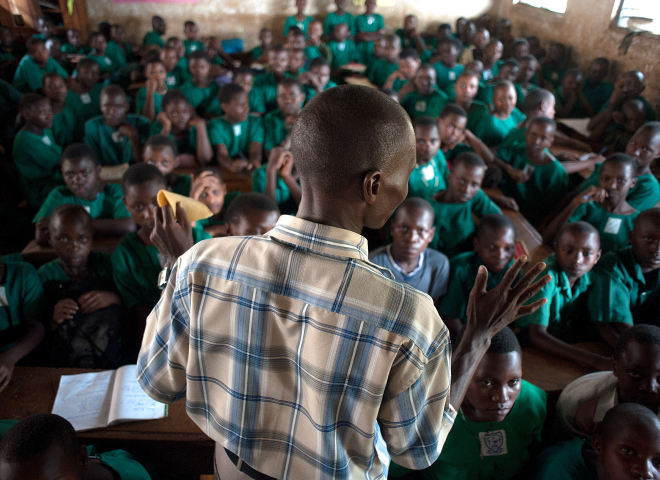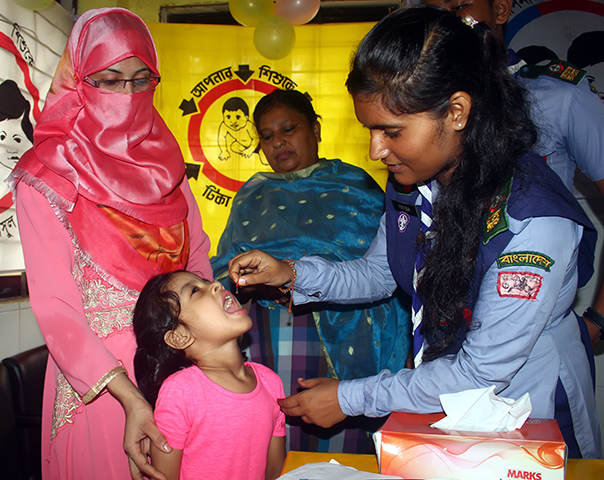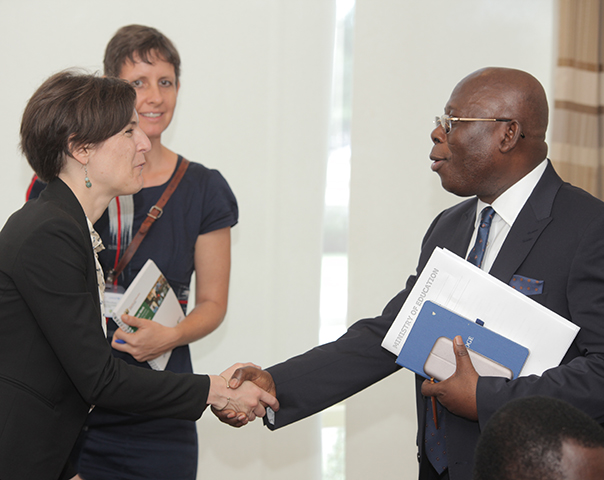The Challenge
High fertility and short spacing between births are both associated with poor health and welfare outcomes for women. Many women report a contraception gap: women say they would like to have greater control over the number and timing of births, but they are not using contraception. Reasons for this gap could include misinformation on contraceptive methods, differences in fertility preferences between men and women, gender norms, or challenges in accessing contraception.
Interventions are needed which help women achieve their desired fertility while also being inexpensive, easy to scale, and fast-acting One potential strategy is to leverage mass media, which has the potential to provide useful information on the benefits of family planning and influence social norms around the adoption of contraception. However, it is hard to rigorously measure the impact of mass media, and evidence is limited especially on two key questions: What is the impact of general exposure to mass media on contraception use? And can mass media be used to broadcast family planning campaigns and increase contraception use?
As of 2021, nearly 20 percent of women of reproductive age (aged 15-49) across sub-Saharan Africa wanted to stop or delay childbearing but did not use modern methods of contraception such as female and male condoms, implants, injectables, or pills.1 In Burkina Faso, 28 percent of women of childbearing age used modern methods of contraception, and 22 percent of women reported that their recent birth or current pregnancy was unintended in 2022.2 Barriers to contraception uptake can include a lack of information about the modern methods available and the health and economic benefits of controlling fertility, concerns about side effects, and misconceptions about infertility caused by modern contraceptives. Gender attitudes and intra-household bargaining issues are likely other barriers to contraception use: most women in rural areas report never having discussed contraception with their husbands and at the same time many report it is appropriate for a woman to hide contraception use from her husband.
Local radio stations broadcasting in local languages dominate Burkina Faso’s media environment, making radio one of the best ways to reach large numbers of women. In this study, researchers have partnered with Development Media International (DMI), an organization that runs television, mobile video, and radio mass media campaigns to change behaviors to improve health and save lives.
The Evaluation
Researchers conducted a randomized evaluation to test the impact of both general exposure to mass media and an intensive family planning campaign on contraception.
To measure the impact of increasing exposure to mass media in general, researchers distributed solar radios to 1,550 women in 1,400 randomly selected households who had no radio at the outset. To measure the impact of the radio campaign, researchers randomly allocated 16 community radio stations between an intervention group (eight stations) where the media campaign took place and a comparison group (eight stations) where regular programing continued.
Of the 1,343 households found to have no radio at baseline in campaign areas, half received radios for all the women in those households. This design allowed researchers to first measure the impact of increasing exposure to mass media in areas where regular programming continued as usual for households with no radio at baseline. It also provided two different methods to measure the impact of DMI’s radio campaign: by comparing women who received a radio to women who did not in campaign areas, and by comparing all women living in campaign areas with those in noncampaign areas.
The campaign, implemented by Development Media International (DMI), aimed to increase knowledge and acceptability of contraceptives as well as address misconceptions about the benefits and risks of high fertility through 90-second radio spots broadcast ten times a day and three one-hour phone-in programs a week. The main themes of the campaign included the health benefits of delaying first pregnancies, increasing the time interval between pregnancies, and reducing the number of total children per woman as well as providing information on different types of safe modern contraceptive methods and discussing the benefits of family planning for the family’s health and financial wellbeing. The campaign lasted two-and-a-half years and was designed to follow the lessons from behavioral science: making family planning issues highly salient, addressing identified information gaps, and being entertaining. The campaign replaced 17 percent of radios’ peak listening time with new (often female-presented) content.
To evaluate the impact on contraceptive use, perceptions of family planning, and general gender norms, researchers collected survey data from 7,500 women of reproductive age (15-49 years old) and 461 clinics as well as radio station logs. They also gathered monthly administrative data from the Ministry of Health on the number of contraceptives distributed by all clinics located in broadcast areas of study radio stations.
One initial concern with the family planning campaign was the risk of potentially increasing domestic violence for women who disagreed with their husband on contraception decision. To monitor this risk researchers collected data on domestic violence to verify that the campaign had no effect on that outcome. DMI also conducted intensive formative research during the campaign implementation and found no evidence that the prevalence of domestic violence increased due to the campaign.
Results
Researchers found evidence that increasing exposure to status quo mass media reduced the use of contraception in this context. However, they showed that this negative effect of mass media can be offset by a high-quality mass media public health campaign based on the lessons from behavioral science. The campaign, delivered at scale, effectively challenged misconceptions about contraception and increased modern contraception use.
Use of Radios: Women across campaign and status quo areas who received radios reported listening to the radio for one additional hour per week compared to women who did not receive a radio. This is equivalent to approximately doubling their mass media exposure.
Take-up of Contraceptives: Receipt of a radio in status quo areas led to a decrease in the modern contraceptive prevalence rate (mCPR) by 5.2 percentage points (a 16 percent decrease) as compared to women who did not receive a radio.3 This negative impact is consistent with a mechanism by which mass media makes more salient, and creates pressure to conform to, the behavior of the typical listener in the community who, in this context, does not use contraception.
Women who lived in areas with the intensive radio campaign and received a radio were 5.8 percentage points (a 17.5 percent increase) more likely to adopt a modern contraceptive method compared to women who did not receive a radio in the same areas suggesting that the intensive campaign overcame the negative impacts of status quo mass media. In addition, the mass media campaign increased mCPR for all women in the campaign area by 5.9 percentage points (a 20 percent increase) relative to the mCPR of 29.5% in comparison areas. The increase in mCPR in campaign areas may be attributable to increased knowledge about contraception and a decline in misconceptions about its side effects. For instance, women in the campaign areas were 9 percentage points less likely (a 35 percent decrease) to say modern contraceptive methods can make a woman sterile.
Beliefs about Contraception and Gender Norms: Women in campaign areas were 7.8 percentage points more likely (a 14 percent increase from 54.7 percent of women in the comparison group) to say that women should control fertility decisions reflecting improved attitudes toward family planning.
Distribution of Contraceptives by Clinics: Administrative data from clinics located in study areas showed highly consistent results with the self-reported survey data. Clinics within 50 kilometers of campaign radio stations had 32 percent more family planning consultations and distributed 11 percent more injectables and 21 percent more pills than clinics in status quo areas.
Researchers found that the mass media campaign was most impactful among women who, prior to the campaign’s start, were already using contraception, reported unmet need, and had more information and positive attitudes toward family planning.
Cost-effectiveness
An IPA cost-effectiveness analysis found that 37,000 more women were using modern contraception as a result of the campaign, which suggests an annual cost of USD 43 per additional woman. Additionally, for one year of contraception coverage for a couple--a typical measurement in this context--the radio program cost 2025 USD 53.
Policy Impact and Implications
In response to the study findings, the mass media campaign was scaled up in January 2019 by DMI to 39 radio stations, an increase from eight in the pilot study, reaching 80 percent of Burkina Faso’s population. Under reasonable assumptions, the researchers estimate that the national scale-up of the campaign led an additional 225,000 women to use contraception at a cost of USD 7.70 per additional woman using contraception annually.
DMI also scaled-up delivery of campaigns promoting contraception in seven countries including Ethiopia, Madagascar, Malawi, Mozambique, Tanzania, Uganda, and Zambia. The combined radio, TV, and social media campaigns in these countries have reached over 121 million people. Other NGOs adopted DMI’s approach and are conducting radio campaigns in other contexts.
Sources
Glennerster, Rachel, Joanna Murray, and Victor Pouliquen. “Media, Social Pressure, and Combatting Misinformation: Experimental Evidence on Mass Media and Contraception Use in Burkina Faso.” Working paper, February 2023.











